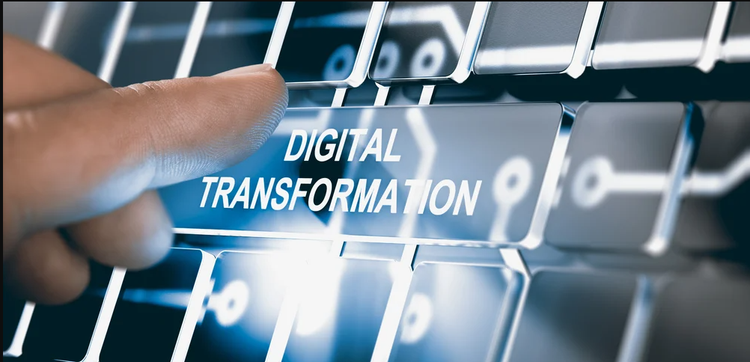
Insights
Please Reboot: Your Digital Transformation Strategy is Compromised
Stephen Coller, David Berney and Cory Slater Scancella
It’s time to confront the facts: after years of trying, most digital transformations have delivered precious little fundamental change in how organizations actually conduct their business.
Stephen Coller, David Berney and Cory Slater Scancella
This blog was co-authored by: Stephen Coller, David Berney and Cory Slater Scancella. Stephen is the Chief Solutions Officer for UST and a Co-founder of AEOS. David is a Digital Transformation Specialist for UST. Cory is the Director of Products and Solutions for UST and a Co-founder of AEOS.
As we think through the ongoing impact of COVID on business and society, business leaders can no longer ignore these shortcomings. This model of transformation is not a recipe for sustainable change, let alone “a thorough or dramatic change in form or appearance.”
It’s still the same profit motive, the same products, the same services, just a different application. Organizational silos remain; data isn’t integrated with microservices, decision making still has to cascade down from the top and middle management still plays the role of a hall monitor.
The result? Your business was deemed non-essential, your warehouses are hot spots, your customers ordered elsewhere and the remainder of your employees are now sold on the advantages of working from home. Probably not the transformation you intended.
COVID IS THE CUE FOR CHANGING YOUR DIGITAL TRANSFORMATION STRATEGY
Like any individual seeking a better path after COVID, we business leaders now have an opportunity to embrace a more thoughtful change by taking transformation more personally: personal to our families, personal to our employees and personal to our customers.
COVID has reminded us of just how interdependent we are. It’s highlighted our responsibility to contribute not just to recovery, but to the creation of more resilient and adaptable organizations and ecosystems that are better able to withstand inevitable future shocks.
If we return to business as usual and default to our existing transformation plans after COVID, we will fail. Our services and infrastructure will remain vulnerable. Our employees and customers will remain exposed to risks we could have otherwise helped prevent.
We can and we must do better. We must acknowledge that employees and partners, not processes, make organizations adaptive and responsive. We need to build new digital transformation strategies based on:
- A better design process, informed by values and purpose, and
- A fundamental reimagining of how a company anticipates and reacts to market and customer events in real-time.
COVID has served to underscore the importance of these foundational ideas. Business leaders must learn from them to develop a transformation strategy that will deliver true change.

1. Transformation Must Be About Values
Transformation should not be an abstract technocratic exercise. It requires courage, honesty, trust and accountability. These simply aren’t possible if you just follow an operational plan.
In order to really mean something, transformation has to be first and foremost about the values and purpose that drove the original founding of the company you lead. Without this focus, nothing will prepare us for the next disruption, because it is values (not value) that drive sustainable transformation.
And the more relatable those values are to the people you serve, the more they will want to be a part of it. People participate because they agree with your purpose, not the roadmap of activities you share with your board and investors. They recognize that these activities will need to adapt to fundamental shifts in demand and supply. They understand that your purpose will provide the guidance required to enable rapid, distributed adaptation – the hallmark of future success.
The good news is that the combination of today’s technology and a journey like digital transformation empowers business leaders to express their organization’s values and purpose more clearly and measurably than ever before. This is critical in an era of increased accountability.
2. Our Infrastructures Must Adapt
COVID has demonstrated that corporate America remains woefully unprepared to handle another pandemic on half the scale of COVID. Too much of our infrastructure, designed for specific system architectures and exposed via APIs, is hardwired to maintain the status quo.
If we are to build a more resilient system post-pandemic, we must adapt or rebuild our present infrastructure so that it can accelerate our capabilities to deliver more resilient and more generative modes of organization and decision making. That means moving our applications to the cloud, as well as our employees and our work.
These in turn are predicated on a group’s ability to combine digital feedback loops with increasingly machine-driven decision making so that we are capable of dynamic adjustment and self-correction.
LET’S REASSESS TRANSFORMATION DESIGN
This new approach to digital transformation strategy — achieving greater organizational resilience in the service of a clear, measurable purpose — means taking another pass at the core foundations of transformation design, which may not have had the same emphasis pre-COVID.
For instance, consider the following segments and questions.
1. Remote, distributed work that enhances, rather than impedes, business continuity.
- How can we use events to trigger workflow across distributed team members, rather than waiting for a manager to mobilize and support them?
- How can we better integrate market signals with workflow in order to improve the speed and quality of decision making and execution?
- Do we need to revise our policy on BYOD and control policies?
2. Worker protection in industries where “6 feet apart” is not a tenable team configuration.
- What mechanism can labor and management employ to ensure and assure worker safety?
- How can that be accomplished without violating employee privacy?
- How do employers take a greater involvement in worker livelihood, including job security, cross-training, and personal well-being?
3. Supply chain exposure.
- How can we gain clearer visibility to the end-end status of our supply chain including our suppliers and distribution partners?
- How could the network diagnose itself and dynamically re-balance between routes and nodes?
- How does your digital transformation strategy support your flight to safety, as well as building the economy of scale required to improve resilience in this critical process?
4. Service flexibility.
- How do we get customers, partners and employees working more directly with each other using shared data and resources?
- How do we enable better coordinative action across widely distributed teams?
- How do we deploy more solutions at the edge, and re-architect around safe APIs that protect people by design?
- How do we deploy pods of small “tiger teams” that attack challenges continuously?
5. Real-time analytics and signal processing.
- How do we achieve better operational proximation to market prediction?
- What sensor networks do we need in place to achieve a complete set of digital feedback loops that might enable more dynamic adaptation across teams and departments?
- How do you create real-time forward- and backward-looking processes to monitor SLAs and expectations that have been promised?
IT’S TIME FOR MEANINGFUL TRANSFORMATION

Let’s stop going through the motions. It’s time to get real about just how willing and able we are to transform. Here’s some advice to that end:
Speak like a human being. We’ve just been through a global pandemic. Stop the happy talk and begin by admitting publicly what has become difficult or unmanageable in your organization using your own words, not copy from Corporate Communications. Your employees and customers don’t read those things.
Start by engaging your employees and customers on your path to be better. Accept that at the end of the day, they hold the key to your relevance and give you a reason to exist.
Make a list of the negative externalities your organization is at risk of or currently contributing to. Your employees and customers already know what they are. They’ll be more inclined to support your transformation if they feel you are addressing these externalities in your program.
Imagine how a network of businesses could interoperate to better serve the needs of your customers. That’s the heart of “big T” Transformation. A brand should evoke a need fulfilled, not an assertion of performance, and partners work best if they work for a common purpose. Start thinking about an efficient ecosystem, rather than an efficient organization. Your employees and customers will directly benefit.
Finally, and most importantly: declare what you stand for and measure it publicly. What is your overarching purpose and how can we be sure you are achieving it? Compared to that level of accountability, CSR programs are just window-dressing.
Now is the time for more fundamental reflection, bolder steps and expansive digital transformation strategies. Lessons are being learned. New habits and expectations are being set among the citizenry. People are in shock. They will be looking to the business community to make a valuable contribution, one that shows clearer commitment to measurable change in how we work and to what end.
Organizations who take steps to exhibit greater accountability and responsiveness to their employees and customers will find themselves setting the pace and being the change we all surely seek. Let’s rise to the occasion and not disappoint: our friends, neighbors and fellow Americans are watching closely.